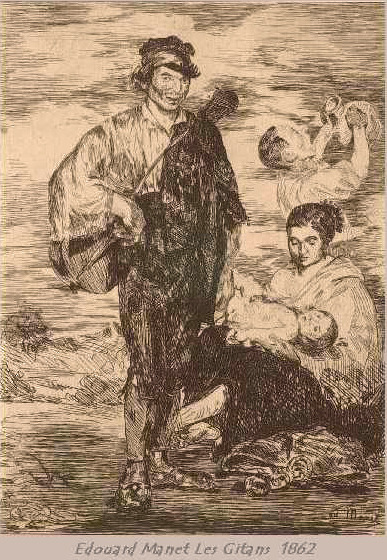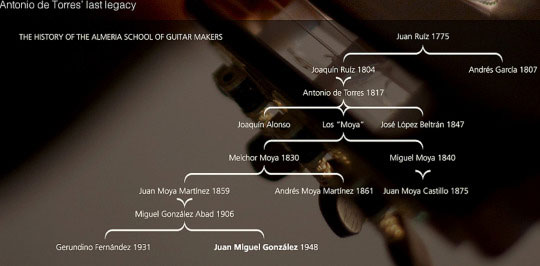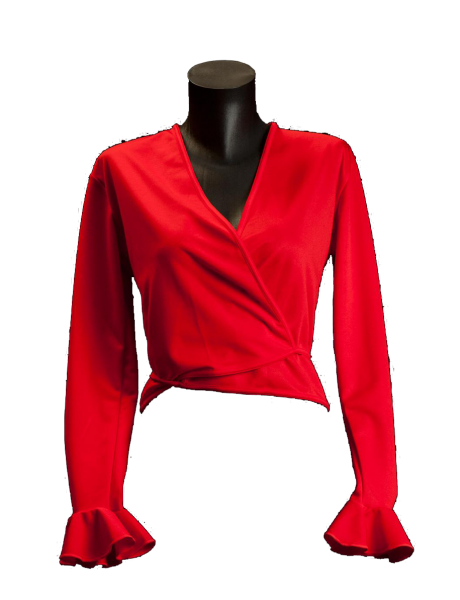- Was sind die Unterschiede zwischen der klassischen und Flamenco-Gitarren?
Der unterschiedliche Klang von Flamencogitarre und Klassischer Gitarre wird, außer durch die Spielweise und den Kapodaster (span. cejilla), hauptsächlich durch zwei Faktoren bestimmt. Zum einen durch das Material, zum anderen durch die Konstruktion.
Flamencogitarren haben einen etwas kleineren Corpus als die klassischen Gitarren, sowohl durch schmalere Zargen, als auch durch die Maße von Decke und Boden beeinflußt. Dadurch klingen Flamencogitarren in der Regel etwas leiser als klassische Gitarren und haben weniger Baßcharakter. In der Mensur (Länge der schwingenden Saite vom Steg bis zum Sattel) liegen die Flamencogitarren natürlich genau so wie die klassischen Gitarren durchschnittlich bei 650 mm. Bei längerer Mensur erscheint die Saite härter durch die höhere Spannung. Da Flamencogitarren eine flachere Saitenlage haben sollten, muß man bei kürzeren Mensuren aufpassen, daß die Saiten nicht klirren und ist gegebenenfalls auf härtere Saiten angewiesen. Daß Flamencogitarren kleiner sind als klassische Gitarren wird man meistens erst feststellen, wenn man sie in einen Gitarrenkoffer legt, der ja meistens für die normalen klassischen Instrumente konstruiert sind. Beim Kauf eines Koffers sollte daher die Flamencogitarre immer mitgenommen werden.
Flamencogitarren sind nicht nur kleiner, sondern auch sehr viel leichter als klassische Gitarren. Das liegt einerseits an der Größe, andererseits aber auch an den Hölzern, die für die Flamenco-Gitarre verwendet werden. Die Decke (span. tapa) der Flamencogitarre ist in der Regel aus Fichte (span. pinabete), so wie auch die der meisten klassischen Instrumente. Die Zargen und der Boden, in der Regel aus demselben Holz, sind bei Klassischen Gitarren meist Palisander (span. palo santo), bei der Flamencogitarre Zypresse (span. ciprés). So kann man Flamencogitarren leicht auch an der Farbe erkennen. Helle Seiten und Boden sprechen für eine Flamencogitarre, daher nennt man sie auch im spanischen "guitarra blanca". Allerdings gibt es auch Ausnahmen von dieser Regel. Viele Gitarristen, vor allem wenn sie aus der Klassik kommen, bevorzugen die sogenannte "guitarra negra". Sie stellt eine Mischform aus klassischer und Flamencogitarre dar: Die Konstruktion einer Flamencogitarre aus dunklen Hölzern. Aber auch innerhalb der reinen Flamencogitarren gibt es kleine Unterschiede. Gitarristen, die Tanz begleiten, bevorzugen oft eine Gitarre mit Zederndecke (span. cedro), die der Gitarre ein großes Volumen verleiht. Die Zederndecke wird in der Regel mit Zargen und Boden aus Fichte versehen.
Eine weitere Eigenheit der Flamencogitarre ist neben dem Schlagschutz (span. golpeador) die Mechanik aus Holz, die sehr an Streichinstrumente erinnert. Da die Gitarre mit Holzwirbeln (span. clavijas) aber anfangs nicht leicht zu stimmen ist, werden heute die Gitarren in der Regel mit den normalen Metallmechaniken bestückt. Holzmechaniken sind auf jeden Fall sehr viel schöner und echter und machen die Gitarre zu etwas Besonderem.
- What are the differences between cedar and spruce soundboards?
In 1862 Antonio Torres (1817-1892) built a guitar with back and sides of papier-mâché, this guitar resides now in the Museu de la Musica in Barcelona. With this experiment Antonio Torres clearly proved that it was the top, and not the back and sides of the guitar that gave the flamenco guitar its responsiveness, its sustain and quality of each individual note.
Specifically for the spruce top tight-grained woods are required to have a lot of little cross silk grain patterns. These little grains, crossing the vertical long grains, are making some kind of bridges between the long vertical grains enabling the wood to respond in all its registers. Spruce is the most common used wood for making flamenco guitar tops. The best quality spruce is German spruce coming from the forests in Switzerland, Italy, Germany and the former Yugoslavia. German Spruce is quite stiff along and across the grains. Its high stiffness in combination with its light weight characteristics, create a high transmission of vibrational energy, making German spruce an excellent choice for the top of flamenco guitar. German spruce has the characteristics of a powerful, direct tone that keeps its clarity when playing strong rasgueados and alzapuas. Engelmann spruce from North America is less stiff resulting in a slightly lower velocity of sound and mainly used for steel string guitars because of its specific ability to absorb the harmonics of steel strings.
When German spruce became very expensive and hard to find, Jose Ramirez III (1922-1995) was the first luthier that introduced red cedar as a successful alternative for German Spruce. Due to the tight grain patterns, tonal responsiveness and stability of cedar, many famous luthiers started making guitars with cedar tops. The velocity of sound of cedar is higher compared to German spruce, cedar also has a higher overtone, but a lower fundamental tone. Spruce projects a brilliant, clear, strongly focused tone. From the first moment you play a flamenco guitar with a cedar top, you will feel the fuller, darker, more wooden, somehow sweeter, but less separated tone. However, this enchanting sound and responsiveness of Cedar does not improve with age. Spruce, on the contrary, opens up by age becoming increasingly responsive and mellow. Since cedar has a lower stiffness along the grain and spruce has the tendency to absorb humidity easily, it is very important that spruce is well-aged and properly dried until it can be used to make a flamenco guitar.
- Spanische Gitarrengeschichte?
From cultures of historical empires, from la Guitarra Latina to the Spanish Guitar
It is generally assumed that the string instruments emerged about 4000 BC from the hunting bow and the sound it produces while shooting. Around 2000 BC the Babylonians frequently made such string instruments, not only in a simple harp or lyre form, but even with a solid wooden neck and a primitive sound box of stretched animal skins. Just like the bow, the strings ware made of woven plant fibres or animal materials. Other sources report the ‘tar’ as a primitive stringed instrument originating from India. 'Tar' means string in the Indo-Aryan language, Sanskrit. This would have led to the Indian sitar (literally ‘three strings’). Considering the size of the Babylonian-Assyrian empire, such stringed instruments were distributed over a large area. Also to the Caucasus, where the Hittites further developed the string instrument into a wooden sound box with round shape, a flat top, resonance holes and fret alike bars on the neck. Such instruments appear in rock carving in the Turkish place Alaja Hüyük. Probably the Hittites brought this string instrument to the Greeks whom called it the ‘kithara’, 'kitos' means' hole ', so 'kithara' means ‘cavity with strings’. The kithara was popular among the art loving Greeks and served as an accompanying instrument for the epic poems the Iliad and the Odyssey. Next, the Romans took over the kithara of the Greeks, bringing the Roman ‘cithara’ to Europe. Already around 400 AC the Romans brought their string instruments to Hispania, currently known as Spain. During the fall of the Roman Empire in the fifth century AD, in Spain, the Roman cithara evolved into the three strings ‘Guitarra latina’. Next when Spain, from the 8th till the 15th century, largely became Moorish territory, the Arabic lute or ‘Al Ud’ was introduced in Spain where it developed into the ‘guitarra Morisca’ or mandore. All that time Spain had two cultures, the Christian and Moorish. As a result both 3 stringed instruments were used commonly, the guitarra latina accompanying Spanish dances and the guitarra Morisca accompanying Moorish dance and poetry.
During the fall of the Moorish Empire, the Moorish culture disappeared as well as the influence of the guitarra Morisca while the guitarra latina remained in Spain. Next important evolution was partly based upon the influence of oriental musical instruments brought home from their world travels by Spanish explorers like Marco Polo. These explorers also brought the use of the bow on string instruments from China to the West. As a consequence many artisans developed several variants such as the ‘vielle’ and the ‘vihuela’. The vihuela was also called ‘vihuela a mano’ when the string instrument was played by the hand instead of with a plectrum. The often luxurious vihuela had six double-strings made of gut and was intended for the fashionable society and aristocracy. In the 16th century, the vielle was only played with a bow, becoming the ancestor of the violin or the cello that we know today. During all this time the guitarra latina had remained and evolved into what we, later on, would call the Spanish guitar. A fifth string, a high E, was added to the guitarra latina, which made her much more easier to play than the double string Vihuela, making her rapidly and much more popular than the Vihuela.
When Spain, in the 16th century, became one of the largest and first global empires in world history, the Spanish versions of the stringed instruments or Spanish guitar spread north of the Pyrenees. Until that time, the lute was the most popular string instrument in the rest of Europe with many troubadours playing the lute, travelling as folk musicians. Because of the complicated way of playing, soon the lute was oppressed by the rise of the guitar from Spain. Lute lovers, including the religious clergy and priests, tried to give the Spanish guitars a bad name by associating them with the scandalous street fun, dances and unnecessary moral ruin. However this attempt worked counterproductive, because it stimulated the Spanish guitar to become more and more popular in the European folk music. Another important development was made in the 18th century. Due to the Renaissance period when Italy became the centre of the guitar world, this time it was not in Spain. In 1779 Gaetano Vinaccia built the earliest six string guitar in Naples, Italy. During the late 18th century, leadership in guitar developments switched to Spain.
- Was ist die Geschichte der Flamenco-Gitarre?
Flamenco guitars have an overwhelming resonance, projection and a percussive, drier sound with punchy, wide-ranging tonality
The flamenco guitar made its appearance as an accompanying instrument in flamenco singing during the 19th century. In 1862 the French artist Manet made, during one of his tours in the Spanish southern part Andalusia, a copper engraving entitled "Les Gitans" showing a Gypsy man carrying a guitar on his back.
 At these times, Flamenco consisted only of singing and clapping. Later, during the period of café cantante or flamenco bars, 1850-1910, the need for a very specific guitar, accompanying flamenco, increased. To play along with the loud volume and often low frequencies produced by the percussive footwork of the dancers and the powerful vocals of the singers, a guitar with a strong, brilliant, somehow sharp and percussive sound was needed. In addition the guitar should respond instantly to hard rasgueados, sensitive falsetas, technically difficult tremolos and also golpes or hand taping on the sound box. Also the guitar that was needed should produce a sound matching the rawness of flamenco singing. The Spanish classical guitar concert was inappropriate for this.
At these times, Flamenco consisted only of singing and clapping. Later, during the period of café cantante or flamenco bars, 1850-1910, the need for a very specific guitar, accompanying flamenco, increased. To play along with the loud volume and often low frequencies produced by the percussive footwork of the dancers and the powerful vocals of the singers, a guitar with a strong, brilliant, somehow sharp and percussive sound was needed. In addition the guitar should respond instantly to hard rasgueados, sensitive falsetas, technically difficult tremolos and also golpes or hand taping on the sound box. Also the guitar that was needed should produce a sound matching the rawness of flamenco singing. The Spanish classical guitar concert was inappropriate for this.It was the legendary Spanish guitar maker Antonio Torres (1817–1892) of Seville, at the end of the 19th century, that succeeded in making the guitar required to accompany flamenco singing and dance, giving the guitar its definitive form. For more information please read Jose Romanillos his wonderful book from 1997, Antonio de Torres his life and work. Most of Antonio Torres his guitars all were cheap flamenco guitars, the ones made from cypress wood instead of from the precious woods from Latin America. Local Gypsies could only afford these cheap guitars to play flamenco. In time they were adapted to small variations and eventually identified as flamenco guitars. Antonio Torres increased the body size and the width of the neck, he increased the scale length, he introduced the seven fan braces instead of three to make a thinner soundboard and improved internal bracing. His guitars were now suitable for concerts; the volume was not too weak anymore to play along with the loud percussive footwork of the dancers and the powerful vocals of the singers. Often it is thought that the flamenco guitar is to be a derivative of the classical Spanish guitar. This is incorrect since the classical guitar as well as the flamenco guitar have been developed, around the same time but separately, from their 19th century predecessors. Strangely enough, the founder of both the flamenco and classical guitar was the same luthier, Antonio de Torres from Seville. A very interesting and striking article, Cultural Origins of the Modern Guitar in the Soundboard magazine edition fall 1997, Richard Bruné stipulates that the modern flamenco guitar is closer to the 19th century guitar of Antonio Torres than the current classical guitars. In this article Richard Bruné indicates that the modern classical guitar is derived from an earlier flamenco type instrument. This guitar founding period at the end of the 19th century is also characterized by Tarrega (1852 -1909) his pioneering playing techniques used by guitarists. Today Juan Miguel Gonzalez Morales, born in Almeria January 17 1947, is the last legacy of Antonio de Torres.

In the early 20th century flamenco guitar makers such as Manuel Ramírez (1864–1916), Domingo Esteso (1882–1937) and later on Marcelo Barbero (1904 - 1956), Miguel Rodriguez (1888-1975) as well as Santos Hernandez (1873–1943) modernized the guitar by modifying design elements of bracing and dimensions. These evolutions gave the flamenco guitars an overwhelming resonance, projection and a percussive, drier sound with punchy, wide-ranging tonality making them perfect instruments for playing without amplification to accompany dance or singing performances, but even in orchestras or large concert halls. Most contemporary Spanish guitar makers build both classical and flamenco guitars, though there are some such as the Conde Hermanos in Madrid, Manuel Reyes in Cordóba, and Andres Dominguez Guerrero in Seville, who are specialized as flamenco guitar makers only.
Although the flamenco guitar originally purely had a supportive role, the flamenco guitar has enriched the musicality of flamenco significantly, immediately increasing the accessibility and impact of the flamenco art in broader segments of the public. Patiño was one of the first flamenco guitarists, formalizing various styles and leading the development of flamenco guitar music. Especially the work of flamenco guitar masters such as Ramón Montoya and Niño Ricardo, at the beginning of the 20th century, enabled the flamenco guitar to evolve beyond its role as accompaniment of singing and dance, becoming a popular solo instrument as well.


